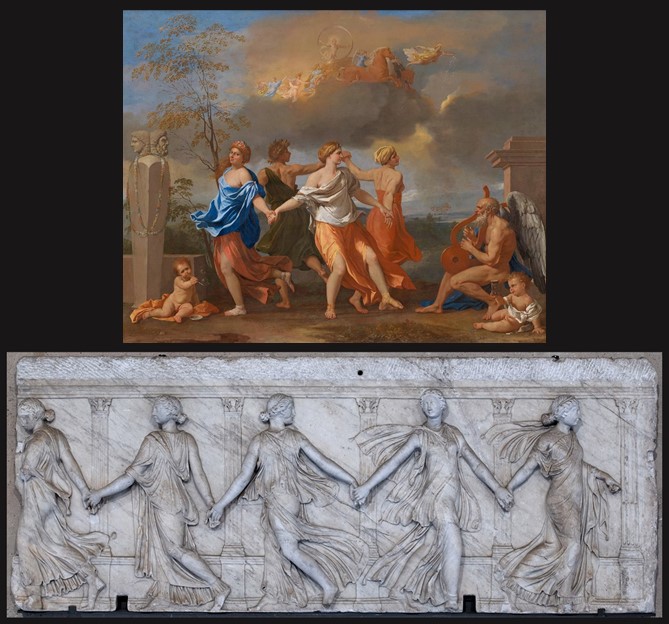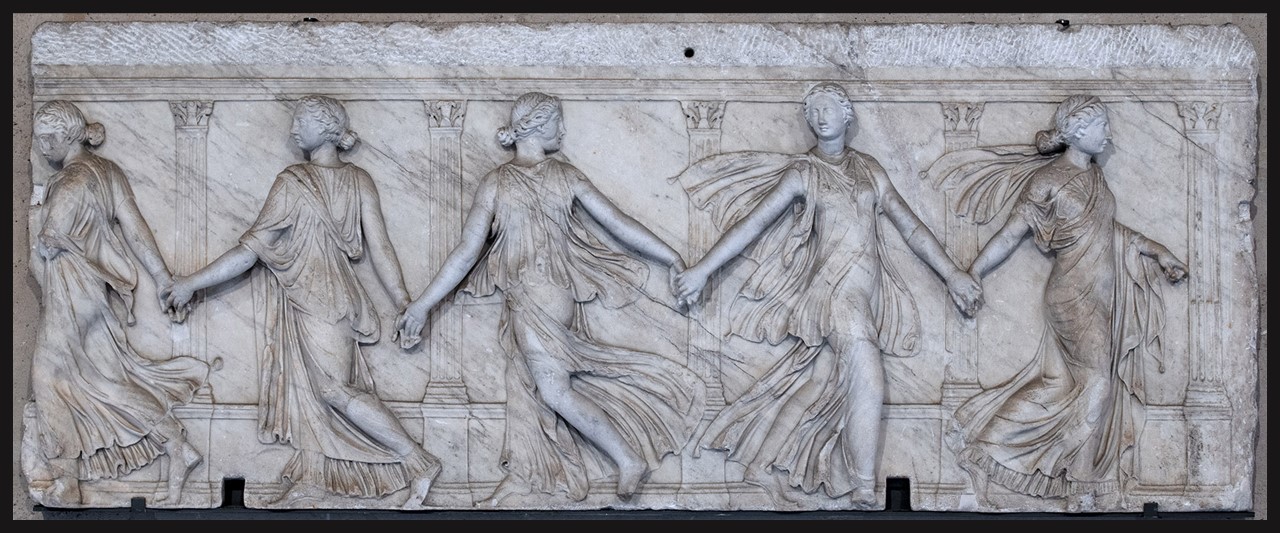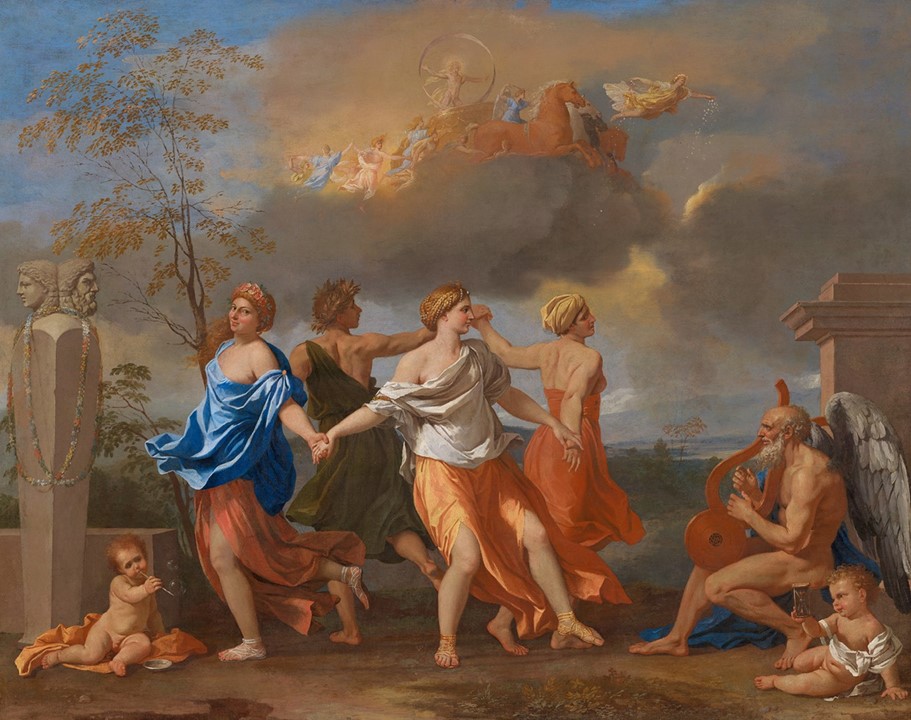
A Dance to the Music of Time, about 1634,
By kind permission of the Trustees of the Wallace Collection, London (P108) © The Trustees of the Wallace Collection
https://www.nationalgallery.org.uk/exhibitions/poussin-and-the-dance/major-loan-announced-for-poussin-and-the-dance
Relief with Five Dancers before a Portico (The Borghese Dancers), 2nd century AD, Marble, 74×186 cm, Musée du Louvre, Paris, France
Photo: Ilya Shurygin 2014 – http://ancientrome.ru/art/artworken/img.htm?id=8452
Thence, fleet as thought, he leaves the earth for Olympos / and goes to the palace of Zeus and the company of the other gods. / Forthwith the immortals take interest in his song and lyre, / and all the Muses, answering with beautiful voices, / hymn the divine gifts of the gods and the hardships / brought upon men by the immortal gods. . Men live an unresourceful and thoughtless life, unable / to find a cure for death and a charm to repel old age. / And the fair-tressed Graces and the kindly Seasons / and Harmonia and Hebe and Aphrodite, the daughter of Zeus, / dance, each holding the other’s wrist. / Among them sings one, neither ugly nor slight of stature / but truly of great size and marvelous aspect, / arrow-pouring Artemis, Apollon’s twin sister. / And with them play Ares and keen-eyed Argeiphontes; / Phoibos Apollon, his step high and stately, / plays the lyre, enveloped in the brilliance / from his glittering feet and well-woven garment. / And Leto of the golden tresses and Zeus the counselor / rejoice in their great souls as they lookupon / their dear son playing among the immortals. This is how the ancient Greek Poet of the Homeric Hymn to Apollo (186-206) describes the fair-tressed Goddesses of Mount Olympus dance… and I can only think of The Borghese Dancers in the Louvre and the Poussin and the Dance Exhibition at the National Gallery (9 October 2021 – 2 January 2022)… and hope I can somehow see them… in London! https://escholarship.org/content/qt1bt36698/qt1bt36698_noSplash_b06fdd7a1448e726a360295a8d2c7f29.pdf and https://www.nationalgallery.org.uk/exhibitions/poussin-and-the-dance

Photo: Ilya Shurygin 2014 – http://ancientrome.ru/art/artworken/img.htm?id=8452
The Borghese Dancers is named after the Villa Borghese in Rome, where the sculptural piece was originally exhibited above the door of the grand gallery, since the early 17th century. The celebrated Roman relief displays five female figures in clinging draperies dancing to a gentle but measured step. It is a fine work of art, typical of the Neo-Attic sculptural style of the 2nd century AD, that emphasizes grace and charm, serenity, and restrained animation. Could the Borghese Dancers be a portrayal of the Dance of the Horae, the Greek Goddesses of the changing Seasons and Time? Could they be just “dancers” holding hands while moving gracefully in front of a wall with a row of Corinthian pilasters? Difficult questions to answer… In 1807, the Roman relief was purchased by Napoleon Bonaparte, brother-in-law of Prince Camillo Borghese. Between 1808 and 1811 it was sent to Paris where in 1820 it was displayed in the Musée du Louvre… where it can still be viewed today. https://wallacelive.wallacecollection.org/eMP/eMuseumPlus?service=ExternalInterface&module=collection&objectId=65841&viewType=detailView and https://www.worldhistory.org/image/10521/borghese-dancers/ and https://www.capronicollection.com/products/borghese-dancers-item-193 and https://collections.louvre.fr/en/ark:/53355/cl010275681

A Dance to the Music of Time, about 1634, by kind permission of the Trustees of the Wallace Collection, London (P108) © The Trustees of the Wallace Collection
https://www.nationalgallery.org.uk/exhibitions/poussin-and-the-dance/major-loan-announced-for-poussin-and-the-dance
The sculptural relief, known as The Borghese Dancers in the Louvre has been an amazing source of inspiration for many artists, among them the Baroque French artist Nicolas Poussin, whose paintings of revelry, dance, and drama are brought together in this first exhibition dedicated and titled Poussin and the Dance, at the National Gallery, in London (9 October 2021 – 2 January 2022). The Museum experts tell us how… Poussin’s paintings of dance are unique… bringing to life the classical world of gods and mortals with wild and riotous movement. The Exhibition, by bringing together the antique sculpture the artist studied, invites us to trace the evolution of his ideas from marble to paper to paint. A pure Joy… Tambourines shake, wine spills, and half-naked figures whirl across the canvas and teach us …invaluable lessons!https://www.nationalgallery.org.uk/exhibitions/poussin-and-the-dance and https://www.nationalgallery.org.uk/exhibitions/poussin-and-the-dance#VideoPlayer103778
For a Student Activity inspired by The Borghese Dancers, please… Check HERE!
Preparing for the POST I came across and read with great interest Sarah Elizabeth Olsen Dissertation: Beyond Choreia: Dance in Ancient Greek Literature and Culture, whose Abstract begins… The chorus of Euripides’ Bacchae heralds the arrival of the god Dionysus by promising that “right away, the whole world will dance in a chorus” (αὐτίκα γᾶ πᾶσα χορεύσει, 114). Their exuberant claim reflects the enthusiasm for dance generally expressed in early Greek sources. Indeed, it has been well established that dance – specifically choreia (communal song-dance) – played a significant role in archaic and classical Greek social life and was thus accorded a high level of value and esteem in art and literature… https://escholarship.org/content/qt1bt36698/qt1bt36698_noSplash_b06fdd7a1448e726a360295a8d2c7f29.pdf